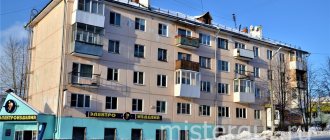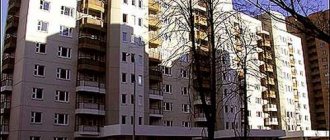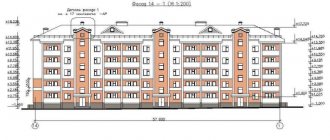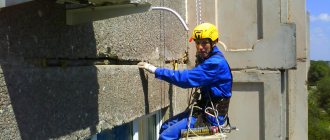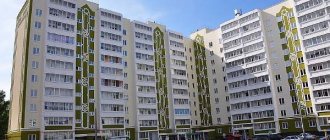What is the height of a 9-story building in meters can be easily calculated using the formula. It is enough to substitute the values of the height of the 1st floor and their number. The result should be a value of about 27 meters. But in reality it may differ and be 28, 30 or more meters. This largely depends on the project under which construction was carried out. We will answer in the article what other values the height of a nine-story building depends on.
Panel nine-story building
Buildings of this type are classified as high-complexity, mid-rise apartment buildings. Entire microdistricts were built en masse before the 90s. Apartment buildings (MKD) built in the 60-90s were named after the reign of which they were built - Khrushchevka, Brezhnevka.
A little history
Since the urbanization process is still in the expansion stage, a city center with private buildings is complete nonsense. The population of large cities is increasing from year to year. Therefore, the problem of people's resettlement remains constantly pressing.
Cities cannot expand indefinitely. The seizure of agricultural land for residential areas cannot lead to anything good. And covering significant distances to get to the right place is also not an option for residents of megacities.
Apartment buildings are nothing new. But the building, capable of housing a hundred families in an area that was previously occupied by 2-3 private buildings, has become a kind of lifesaver. After all, if you resettle this number of people into one-story houses, you will need to build up an entire block.
An area with standard nine-story buildings Source 3dvector-pro.ru
How to calculate the optimal ceiling height for design and renovation
As can be seen from the descriptions of different housing, the standard ceiling height may vary, it can be clarified and compared in the table below.
Table 1. Standard shelf height in different types of houses.
Type of buildingAverage ceiling height, m
| "Stalin" houses, old buildings | 3,0-3,6 |
| "Khrushchev" | 2,5-2,7 |
| "Brezhnevki", apartments with improved layout | 2,6-2,7 |
| Panel and block houses | 2,5-2,75 |
| Modern apartment buildings | 2,7-3,2 |
| Private houses, low-rise buildings | From 2.5 and above according to the project |
In addition to the standard one, there is such a thing as optimal ceiling height. It takes into account not only the SNiP requirements for microclimate and safety, but also the ergonomics of the premises and the combination of dimensions in all three dimensions. It should be noted that the optimal ceiling height should not be lower than the regulated one.
Experienced developers recommend choosing the optimal ceiling height taking into account several factors described in the table.
Table 2. Selection of optimal ceiling heights in various rooms.
Conditions, illustrations Brief description
| Condition 1. Microclimate and air exchange | For living rooms and kitchens, the optimal ceiling height in the final finish should be no less than the height of the tallest family member plus 1 meter. This is due to the fact that the upper meter layer of air in the room contains a maximum of dust, bacteria and harmful gases formed during breathing and operation of heating devices. To ensure good health, you need to avoid inhaling air from this layer of air. With an average height of 170 cm, the finished ceilings are 2.7 meters high. |
| Condition 2. Heating and costs for it | You should not excessively increase the ceiling height - this will significantly increase the cost of heating. Thus, for a house with an area of 100 m2, an increase in the distance from floor to ceiling by 30 cm threatens to increase the cubic capacity of the building by 30 m3, which will require the installation of more powerful heating equipment and increase heating costs. |
| Condition 3. Number of storeys and layout | For a two- and three-story house, too high ceilings are also undesirable, and not only because of increased construction costs. The staircase to the upper floors with an increased ceiling height will take up a large area or will have a too steep slope, which is inconvenient and sometimes unsafe. If you want a spacious living room or hall in a two-story house, use a layout with a second light, as shown in the picture. In such a house, the ceiling height in the living room or hall occupies both floors. |
| Condition 4. Purpose of the premises | It makes no sense to make high ceilings in rooms with temporary occupancy: in a pantry, garage, small corridor. A height of 2.2-2.5 meters is quite sufficient for them. Also, you should not make high ceilings in the bathhouse and sauna - this will make it more difficult to heat it to the desired temperature. They have enough 2.2-2.3 m. |
| Condition 5. Room area | The basic rule: the more spacious the room, the more appropriate high ceilings are. So, for a living room or dining room with an area of 20 m2 or more, a ceiling height of 3.0-3.5 meters is suitable; for the kitchen, bedroom and nursery, 2.7-3.2 meters is enough; for a bathroom – 2.7-3.0 meters. You can achieve different heights in different rooms through suspended or tensioned structures and ceiling decoration. In addition, communications and ventilation systems can be hidden under them. |
Calculation of the stairs to the second floor
Although the standard ceiling height is regulated by code, its value can vary greatly. When purchasing a new or secondary home, this parameter must be clarified in the technical passport for the apartment or house, or measured independently. When building a private property, it is better to be guided by personal needs and preferences, because the correctly chosen height of the premises will not only create the desired style and interior in the house, but also provide a comfortable environment there.
In pursuit of standards and savings
The number of floors in the house was designed purely on economic principles. If the city budget did not allow spending money on expensive elevator equipment, then buildings no higher than five floors were planned. But if the latter was included in the project, then the house was no longer built below nine levels. To get the most out of the building.
Standard nine-story panel house Source hypecrib.com
They did not want to build standard buildings higher than this. Because it became necessary to significantly rework the project, introducing expensive elements into it. Because this was required by safety measures for residents.
When standard designs for high-rise buildings were developed, the maximum of nine floors was observed for a simple reason. Fire trucks of that time had a standard ladder with a reach of 30 meters. Therefore, in case of trouble, rescuers could evacuate people from the top floor.
If the building for any reason exceeds these dimensions, it must be equipped with an additional smoke-free staircase with mandatory passage through open balconies. Therefore, it was forbidden to glaze the latter, as well as to force them with things.
Nine-story building with an external fire escape Source lestnitsygid.ru
Adviсe
To make the living space of a private home more aesthetically pleasing, there are many interior solutions that most people simply do not know about. For people who have chosen standard-height ceilings, the following recommendations can be given to add visual beauty and volume to the room:
- It is worth using shiny stretch ceilings - they stretch out the space, saturating it with reflected light;
- in the decoration of the walls you need to add more vertical lines and mirrors - this will make the space deeper and visually higher;
- It is advisable to paint the walls and ceiling in the same tone, and the floor a tone lower, that is, darker;
- It is better to make the ceiling light;
- Windows should be placed closer to the ceiling so that more light falls on it than on the floor.
Methods for determining the height of a building
The question of how many meters high a house is began to bother residents immediately after the construction of the first high-rise buildings. It was based on simple curiosity. And also pride in my hometown.
Nine-story building from the time of Brezhnev Source domofoto.ru
People reasoned differently and used three methods:
- One floor was taken as the general standard of three meters. Then multiplied by the number of levels.
- We personally measured the height of the ceilings. Then we followed the previous scheme.
- If there was access to the project, they learned the most accurate figures from the latter.
The first two methods literally repeat each other. Because even knowing the exact height of the ceiling in the apartment, simply multiplying by the number of floors will not be enough. The result will be a very inaccurate value. After all, the calculations will not take into account the basement of the building and the attic space.
Plus, you need to know the thickness of the interfloor slabs. Therefore, even after adding the last parameter to the ceilings and getting the same average three meters, you need to remember to add the foundation and roof. As a rule, after all the manipulations with the numbers, an average value of 30 meters is obtained.
Nine-story building during perestroika Source nar.ru
We can stop there. But more meticulous people can contact the department that stores all standard city building designs. And upon an official request, all accurate data will be provided from the archive. The only disadvantage of this method is its slowness. After all, no one is eager to satisfy ordinary curiosity.
It is possible that you will have to resort to cunning and provide a serious basis for the request. Or take advantage of your acquaintance and get information through a personal channel.
Common types of Soviet-era buildings
In the terminology of realtors and those involved in renting out housing, terms constantly appear that are not always familiar to the average person. These are conditionally generalized names of buildings erected in one period or another, when construction was carried out at an accelerated pace. Initially, the construction of higher-rise buildings began with 4 and 5 floors, but over time, preference was given to the latter. They envisioned a larger number of separate apartments that could be given to people for resettlement.
An undeniable advantage, compared to even taller buildings, was the opportunity not to equip an elevator, and thus save additional money. According to construction standards, it was on the fifth floor that the opportunity to do without installing an elevator, its shaft, a lifting mechanism and further costs for repairs and maintenance ended.
History of 5-story buildings
Five-story houses began to be built in Moscow and St. Petersburg even before the war, but after its end, in 1948, the first attempts to build experimental houses began using frames and panels as standard parts for assembly.
By appearance and degree of wear and tear after use, one can quite easily distinguish between three periods of Soviet construction, which were popularly named after the names of the then leaders of the country.
Over time, they even took root in official documents, and now, when talking about projects, they use three common terms:
- “Stalin buildings” are houses that have retained a presentable and well-groomed appearance until now, because their service life was included in the design for 125 years or more. They can be easily distinguished by the presence of architectural decorations, stucco moldings, plinths, columns, Soviet paraphernalia, pompous style and the presence of high first floors for public spaces in street buildings. The ceilings in the apartments of such houses were more than 3 meters, since the planning took into account a certain volume of air for each resident. “Stalin buildings” were always more than 20 m high, due to the spans between floors and the strong roof that reliably protected the building.
- In a five-story panel house, the construction of which began under Khrushchev, the ceiling height was sometimes 2.48 m (all parameters depend on the standard project number). In order to save money, they first stopped building an iron frame, leaving only reinforced concrete panels; sometimes they did not make a full-fledged attic; in other options there was no basement. Later, the ceilings became a little higher, and then they reached their maximum height when designing the last series (2.64 m), but the roofs were no longer gable, but flat, there were no longer columns or plinths. However, for street buildings, the design with a higher ground floor was still used, in which premises were built for shops, organizations or public needs. Hence the approximate height of the Khrushchev building, which ranges from 14 to 15 meters.
- The construction of the Brezhnevka took place according to new, modified design documents. Although the Unified Construction Catalog of Parts was still used, such houses had wide landings, ceilings rose to 2.7 m, and almost everywhere there was a full attic and a deep basement. Even visually you can determine that the Khrushchev panel building is noticeably different from the Brezhnev building. Apart from the difference in height (even 20 cm in terms of five floors is a meter, not taking into account the attic and ceilings), there is also the appearance. The period for which the Khrushchev buildings were designed has completely expired, but the more solid construction still looks relatively normal.
The 5-story brick residential building of the Stalin and Khrushchev eras is also very different in visual perception. The Stalinist house had a foundation and a gable roof, which occupied about 6.5 m, and with the addition of ceiling heights, this figure starts from 21.5 m. Although everything also depends on the ceilings between the floors, and they were different. The height of the People's Commissar's Stalin could reach even higher levels. Brick Khrushchev buildings, where, for the sake of economy, there were no frills, and the ceiling height reached less than 2.5 m, could be 14 meters in vertical dimension.
Actual floor height
Nine-story buildings in the post-Soviet space were built according to different standard designs. And, practically, everyone had their own ceiling height in the rooms. In most cases, this depended on the use of panels, which also had different sizes.
Unites the height of the ceilings of all buildings of nine floors and above only one. They are all larger than the Khrushchev standard provided. And it ranged from 2.45 to 2.55 meters. But after the change of state leader, construction standards were also replaced. It was decided that Soviet residents should breathe much more freely.
Modern nine-story building Source ruzray.ru
Therefore, in nine-story buildings with new layouts one could find ceilings whose height varied from 2.65 to 2.75 meters. The change of power brought new meanings and new brick buildings of nine floors began to have ceilings up to 2.85 meters. As for modern high-rise buildings, you can see in them the distance from the floor to the arch as much as 3 meters and 20 centimeters. True, only some elite apartments have such dimensions.
All panel houses had minimum parameters. The brick buildings were already distinguished by their large space. And the most optimal dimensions came from monolithic structures. The technology for their construction was developed not so long ago, so only modern buildings have really high ceilings.
Dacha: main provisions of SNiP
Let's start with a simple one, since the rules for a dacha are less strict when compared with a building that has the status of a residential building. If you are planning to build a summer house, then you need to know that the height of the ceilings in the premises should be at least 2.2 meters.
There must be a source of water at the dacha - be it a pipeline, a well or a well. Other utility infrastructure is optional. But the water must be suitable for drinking - if necessary, the liquid will be checked for bacteria, salts and Ph level. The bathroom is one of the important issues, but at the dacha an ordinary toilet will suffice; SNiP does not oblige the owners to install a sewer system.
Site requirements
If the requirements for communal infrastructure are minimal, then for a summer cottage there are many points set aside in the SNiP document. Typically, there are no large summer cottage plots in SDT, so lovers of large houses who decide to build them on the edge of the plot will create discomfort for their neighbors. The rules stipulate that the building must be at least three meters from the neighbor's fence.
This diagram shows in detail the requirements for the placement of various buildings on the site. The data is current for both 2015 and 2017.
Also in SNiP for summer cottages there is such a thing as a “red line”. This term denotes the border that separates public areas from dachas and residential buildings. The minimum distance from the dacha to the red line is 3 meters if there is a passage, or 5 meters if your house is located on a full-fledged street.
SNiP also indicates the distance to neighboring buildings; these standards are aimed at eliminating the risk of fire. The distance from one private house to another depends on what material the building is made of. For example, between houses made of stone and block buildings that contain reinforced concrete, the distance should be at least 6 meters. If both houses are wooden - from 15 meters, if they have wooden floors - from 8 m, there must be a distance of at least 10 meters between the wooden and stone buildings.
SNiP provides for measurements from the following elements of the building:
- From the edge of the porch or roof overhang (if present);
- From the base;
- From a flat wall (this distance is taken if there is no base).
Building density is also important, so SNiP has corresponding rules. The document states that with standard sizes (6-12 acres), the dacha plot should have no more than 30% of the built-up area.
Private house: basic provisions
This plan reflects the basic requirements for a private house on the site. The rules cover all parts of the development site.
First, it’s worth talking about the rooms, since SNiP indicates a minimum set of rooms:
- boiler room;
- living space;
- pantry (can be replaced with a dressing room);
- kitchen (alternatively there is a kitchen niche or dining room).
SNiP rules for a residential building are more demanding, so there are standards for the size of rooms. For example, the bedroom should not be less than 8 square meters, and the living room should not be less than 12 square meters. The distance from the ceiling to the floor must be at least 2.5 meters; as for the attic floor, this size is allowed at 2.3 m. If there is enough sewerage for a dacha, then for a private house all amenities must be provided - heating, water, electricity , as well as a full bathroom.
There is a provision in SNiP 2022 that obliges people to have a radio. At first glance, this is funny, but it is precisely through this means that rescue services inform residents about various man-made disasters and natural disasters.
Fire safety
This is the main question. Many residents of private houses are already faced with the fact that until their home fully complies with fire safety, the Ministry of Emergency Situations will not issue a permit. The SNiP rules contain a separate chapter, which includes 19 points. They will remain unchanged in 2022.
- emergency exits of a private house;
- presence of fire detectors;
- fire partitions.
Let's say right away that it is quite difficult to comply with all these standards for a summer cottage or a private house, but there is a simple solution - build a house with one or two floors. In this case, you will be freed from the requirements for fire resistance of the materials from which the walls of the cottage are made.
Roof and plinth
None of the houses stand directly on the surface of the earth. To withstand the enormous load, and one entrance of a nine-story building weighs at least 15 tons, a powerful foundation is needed. And to equip it, they dig a fairly deep pit.
Project of a modern nine-story building Source Yandex.Zen
The main foundation is located underground, so these dimensions should not be included in the calculations. But part of it necessarily protrudes above the surface. This place is called the basement. It usually contains basements. Its height is on average one meter from the surface of the earth.
But most often this value is minimal, since the foundation of each building has its own characteristics. And you can often find nine-story buildings, the basement of which is much more than one meter. But if calculations of the height of a building are made using the first two methods, then no more than a meter is always added to the number of floors.
Literally every nine-story building has another technological premises, in addition to the basement. They are located under the roof. Space has different goals. For example, it serves as a place for elevator equipment. And the average height of this zone reaches two meters.
Calculation of the mass of a frame house
In accordance with the provisions of the updated edition of SNiP 2.01.07-85 “Loads and impacts”, the specific gravity of 1 sq. m of frame structure – 150 kg. This is not surprising: for the construction of a one-story frame building, 70 - 100 square meters. m requires at least 150 kg of fasteners, and the weight of one post of a frame wall with a cross-section of 40x100 mm and a length of 3 m is 6 kg!
The simplest way to calculate is to weigh all the elements used in assembling a frame house and sum up the indicators. But this is practically impossible in practice, so various formulas are used to calculate the weight of a building. One of them is summing up the weight of the main structural elements: walls, roof, ceilings. To the data obtained, add the estimated mass of snow cover formed on the roof in winter, as well as the weight of windows and doors (it is indicated in the accompanying documentation for the products). At the end of the calculations, add 15% of the resulting amount to compensate for possible inaccuracies.
The SNiP standards indicate: the weight of the attic floor is up to 300 kg/sq. m subject to insulation with materials with a density of over 500 kg/sq. m. The density of insulation materials is indicated in the accompanying documentation. With these data, it is easy to calculate the total mass of the insulation.
It is not difficult to obtain approximate data on the weight of a frame house: it is enough to know that the standard weight of a wall with fixed insulation and a thickness of 15 cm is about 40 kg/sq. m. With an average density of 200 kg/cubic. m, the weight of wooden beams is 70 - 100 kg/sq. m.
For clarity, we will carry out the calculation using a simple example: a one-story house 8x9 m with a ceiling height of 2.5 m and 2 interior partitions. The total length of the walls is 34 m, and the total length of the partitions is 14 m. We calculate the total area of the walls by multiplying their total length by height: 48 * 2.5 = 120 sq. m. Knowing the average weight of 1 sq. m of wall, we calculate: 120 * 40 = 4.8 tons. The area of the floors is equal to the area of the house - 72 sq. m. m. However, the attic floor protrudes beyond the building by 1 m on each side, so its area will be 90 sq. m. m. The average weight of the basement floor (72 * 100) is 7.2 tons, and the attic floor is about 6.3 tons. The easiest way to choose the right foundation is to seek help from engineers who have specialized in designing frame houses for over 8 years!
How to obtain permission for individual housing construction? What does a developer need to know?
Limiting authorities follow the development procedure and approve documents for individual housing construction according to RSN 70-88. Thanks to them, not only the accuracy of site development is determined, but also the layout of the home and auxiliary buildings. This project needs to be carefully considered, because what is not shown in the plan will be recognized as an unauthorized structure and must be demolished or re-approved.
Without permission, that is, before the plan is approved and documents are received, work should not begin, otherwise serious problems may arise. In order to find out exactly what documents will be required to start construction, you should read the “Code of Rules for Design and Construction SP 11-III-99”.
In order to obtain permission, you need to contact the BTI or the city architectural department to provide:
- application for planning permission;
- documents establishing the right to use the site;
- certificate of field determination of boundaries, placement of buildings, etc.;
- cadastral plan of the site;
- House project.
Once issued, the permit is valid for 10 years.
